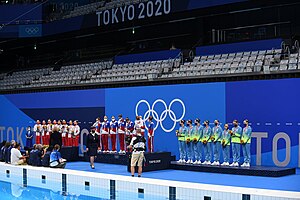
Synchronized swimming or artistic swimming is a sport where swimmers perform a synchronized choreographed routine, accompanied by music. The sport is governed internationally by FINA. It is traditionally a women's sport, although FINA introduced a new mixed gender duet competition that included one male swimmer in each duet at the 2015 World Aquatics Championships and LEN introduced men's individual events at the 2022 European Aquatics Championships.

The Code of Points is a rulebook that defines the scoring system for each level of competition in gymnastics. There is not a universal international Code of Points, and every oversight organization — such as the FIG, NCAA Gymnastics, and most national gymnastics federations — designs and employs its own unique Code of Points.

At the 1996 Summer Olympics in Atlanta, the team event in women's synchronized swimming was contested. It was the first appearance of the team event, which replaced the duet and solo events held previously.
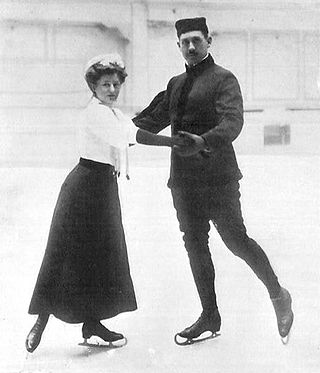
Pair skating is a figure skating discipline defined by the International Skating Union (ISU) as "the skating of two persons in unison who perform their movements in such harmony with each other as to give the impression of genuine Pair Skating as compared with independent Single Skating". The ISU also states that a pairs team consists of "one Woman and one Man". Pair skating, along with men's and women's single skating, has been an Olympic discipline since figure skating, the oldest Winter Olympic sport, was introduced at the 1908 Summer Olympics in London. The ISU World Figure Skating Championships introduced pair skating in 1908.
The ISU Judging System (or the International Judging System (IJS)), occasionally referred to as the Code of Points (COP) system, is the scoring system that has been used since 2004 to judge the figure skating disciplines of men's and ladies' singles, pair skating, ice dance, and synchronized skating. It was designed and implemented by the International Skating Union (ISU), the ruling body of the sport.
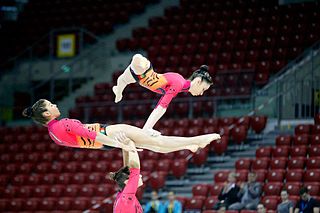
Acrobatic gymnastics is a competitive discipline of gymnastics where partnerships of gymnasts work together and perform figures consisting of acrobatic moves, dance and tumbling, set to music. There are three types of routines; a 'balance' routine where the focus is on strength, poise and flexibility; a 'dynamic' routine which includes throws, somersaults and catches, and a 'combined' routine which includes elements from both balance and dynamic.

The women's team event at the 2004 Summer Olympics in Athens, Greece, took place at the Athens Olympic Aquatic Centre from 26 to 27 August. The Russian synchronized swimmers delivered a superb performance to defend their Olympic title in the event, having received a straight line of five perfect marks from the judges for a composite score of 99.501. Japan maintained a silver-medal streak on its second Olympics by a single point short of Russia's score with 98.501, after displaying their explosive lifts and quick changes of pattern throughout the routine. Having failed to secure an Olympic medal in the sport from the previous Olympics, the U.S. squad assembled a colorful demonstration of multiple sequences and flying leaps to hold on for the bronze with a score of 97.418.
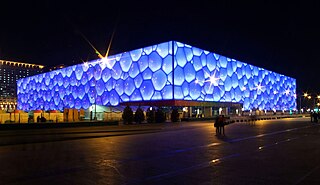
The women's duet synchronized swimming event at the 2008 Summer Olympics was held from August 18 to 20, at the Beijing National Aquatics Center.

The women's team event at the 2008 Summer Olympics in Beijing, China, took place at the Beijing National Aquatics Center from 22 to 23 August. The Russian squad had displayed their complex choreography with an unmatched precision in the free routine to defend their Olympic title for the third straight victory, having received a nearly perfect mark of 99.500 by the judges. Spain picked up a silver with 98.251 points, while the Chinese squad surpassed the 2004 Olympic silver medal team Japan by nearly a two-point advantage to claim a bronze for the host nation's first ever Olympic medal, recording a composite score of 97.334.

The women's team event at the 2012 Summer Olympics in London, United Kingdom, took place at the Aquatics Centre from 9 to 10 August. Russia maintained its dominance in the sport, as the team delivered a nearly perfect, complex choreography for another gold medal at its fourth consecutive Olympics, having received a powerful, composite score of 197.030 by the judges. Meanwhile, the Chinese squad resisted the challenge from Spain on a historical breakthrough to add a silver in the event with 194.010, edging the Spaniards out of the pool to accept the bronze for a total score of 193.120.
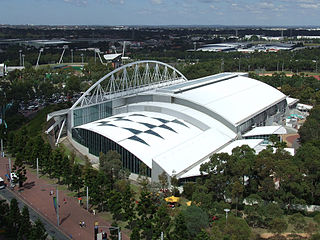
The women's team event at the 2000 Summer Olympics in Sydney, Australia, took place at the Sydney International Aquatic Centre from 28 to 29 September. The Russian synchronized swimmers performed a witch-themed routine with a variety of flying lifts and multiple pattern changes to score 99.146 out of a possible 100 points for an Olympic gold medal in the team event. The Japanese squad excelled in the artistic impression component for a score of 40 in the final free routine, but had to be satisfied with a second Olympic silver at these Games, having received an overall total of 98.860. Meanwhile, the Canadian octet snatched the bronze with a composite score of 97.357, finishing ahead of France by almost a full point (96.467). The U.S. team failed to collect an Olympic medal for the first time since the sport's introduction in 1984, as the swimmers finished the routine in fifth at 96.467.
Degree of difficulty is a concept used in several sports and other competitions to indicate the technical difficulty of a skill, performance, or course, often as a factor in scoring. Sports which incorporate a degree of difficulty in scoring include bouldering, cross-country skiing, diving, equestrianism, figure skating, freestyle skiing, gymnastics, rhythmic gymnastics, surfing, synchronized swimming and trampoline. Degree of difficulty is typically intended to be an objective measure, in sports whose scoring may also rely on subjective judgments of performance.
The Women's team event at the 2016 Summer Olympics in Rio de Janeiro, Brazil, took place at the Maria Lenk Aquatics Center from 14 to 16 August.
The women's duet event at the 2020 Summer Olympics in Tokyo, Japan, took place at the Tokyo Aquatics Centre from 2 to 4 August 2021. It was the 9th time the women's duet event was held at the Olympic Games.
The men's synchronized 3 metre springboard diving competition at the 2020 Summer Olympics in Tokyo was held on 28 July 2021 at the Tokyo Aquatics Centre. It was the 6th appearance of the event, which has been held at every Olympic Games since the 2000 Summer Olympics.
The women's synchronized 3 metre springboard diving competition at the 2020 Summer Olympics in Tokyo was held on 25 July 2021 at the Tokyo Aquatics Centre. It was the 6th appearance of the event, which had been held at every Olympic Games since the 2000 Summer Olympics.
The men's 10 metre synchronized platform diving competition at the 2020 Summer Olympics in Tokyo was held on 26 July 2021 at the Tokyo Aquatics Centre. It was the 6th appearance of the event, which has been held at every Olympic Games since the 2000 Summer Olympics.
The women's 10 metre synchronized platform diving competition at the 2020 Summer Olympics in Tokyo was held on 27 July 2021 at the Tokyo Aquatics Centre. It was the 6th appearance of the event, which has been held at every Olympic Games since the 2000 Summer Olympics.
The men's 3 metre springboard diving competition at the 2020 Summer Olympics in Tokyo was held in 2021 at the Tokyo Aquatics Centre. It was the 26th appearance of the event, which has been held at every Olympic Games since the 1908 Summer Olympics.
The women's 3 metre springboard diving competition at the 2020 Summer Olympics in Tokyo was held from 30 July to 1 August 2021 at the Tokyo Aquatics Centre. It was the 24th appearance of the event, which has been held at every Olympic Games since the 1920 Summer Olympics.
